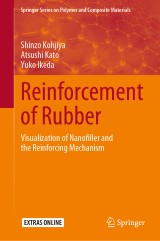Details

Reinforcement of Rubber
Visualization of Nanofiller and the Reinforcing MechanismSpringer Series on Polymer and Composite Materials
|
CHF 118.00 |
|
| Verlag: | Springer |
| Format: | |
| Veröffentl.: | 01.04.2020 |
| ISBN/EAN: | 9789811537899 |
| Sprache: | englisch |
Dieses eBook enthält ein Wasserzeichen.
Beschreibungen
This book presents the most recent description of rubber reinforcement, focusing on the network-like structure formation of nanofiller in the rubber matrix under the presence of bound rubber. The resultant filler network is visualized by electron tomography applied to rubber. In the case of natural rubber, the self-reinforcement effect is uniquely functioning, and new template crystallization is suggested. Here, the crystallites are also believed to arrange themselves in a network-like manner. These results are of great use, particularly for engineers, in designing rubber reinforcement. <div><br></div>
Part I Filler Reinforcement of Rubber.- 1. Rubbery Materials and Soft Nanocomposites.- 2. Filler and Rubber Reinforcement.- Part II Analysis of Nanofiller Dispersion in Rubber Matrix.- 3. Principle and Practice of Three-Dimensional Transmission Electron Microscope (3D-TEM).- 4. Nanofiller Dispersion in Rubber as Revealed by 3D-TEM.- 5. Reinforcing Mechanism of Rubber by Nanofiller.- Part III Non-Carbon Reinforcement of Rubber.- 6. Particulate Silica Reinforcement of Rubber.- 7. Rubber Reinforcement with Lignin.- 8. Self-Reinforcement in Natural Rubber: Template Crystallization.- Part IV Prospective Views on Rubber Reinforcement.- 9. Reinforcement in the Twenty-First Century. <div><br></div>
<div><b>Shinzo Kohiya</b> received his PhD from Kyoto University in 1974. His reserach interests include kinetic studies on ionic polymerizations, development of soft rubbery materials of high functionality, structural studies on polymeric amorphous materials and their applications, and scientific elucidation of filler dispersion in rubbery matrix. He is currently a professor emeritus, Kyoto University. He is the author of several books, and about 350 papers which appearred in decent international journals. He won the Oenslager award from Society of Rubber Industry, Japan, in 1994. He has 23 years, 13 years and 3 years of teaching experiences at Kyoto Institute of Technology, Kyoto university, and Mahidol University in Thailand, respectively.</div><div><br></div><b>Atsushi Kato</b> rreceived his PhD from Tohoku University in 1985. His research interests include unusual stress-strain properties of natural rubber vulcanizates with high primary molecular weight, fatigue characteristics ofglass fiber reinforced polyamide, study on microfracture mechanism of glass fiber reinforced polycarbonate by using acoustic emission, optical transparency and silica network in cross-linked natural rubber as revealed by spectroscopic and three-dimensional transmission electron microscopy technique, reinforcement mechanism of carbon black (CB) in natural rubber vulcanizates, and so on. He is currently working on development of analysis technology of soft materials at the automotive analysis department of NISSAN ARC, LTD. He won the Materials Life Society Review Award from the Materials Life Society, Japan in 2009, and the Rubber-Technical Merit Award from the Society of Rubber Science and Technology, Japan in 2012. <div><br></div><div><b>Yuko Ikeda</b> received her Ph.D. from Kyoto University in 1991. The title of thesis was “Studies on Blood-Compatible Polyurethanes with Triblock Polyether Soft Segments”. Her research interests include fundamental studies on the sulfur cross-linking and reinforcement of rubbers by using new analytical methods. Characterization of natural rubbers are also studied by using synchrotron X-ray analyses. She is currently a professor at Kyoto Institute of Technology. She published 137 original papers, 67 review papers and 16 essays, and contributed to 48 books. She won the 29th Oenslager award for her study on “Fundamental study on cross-linking of rubber” from Society of Rubber Industry, Japan, in 2014. She has 31 years of teaching experience at Kyoto Institute of Technology.</div>
This book presents the most recent description of rubber reinforcement, focusing on the network-like structure formation of nanofiller in the rubber matrix under the presence of bound rubber. The resultant filler network is visualized by electron tomography applied to rubber. In the case of natural rubber, the self-reinforcement effect is uniquely functioning, and new template crystallization is suggested. Here, the crystallites are also believed to arrange themselves in a network-like manner. These results are of great use, particularly for engineers, in designing rubber reinforcement. <div><br></div>
Visualizes the comprehensive reinforcement mechanism by application of 3D-TEM/electron tomography to rubber Presents and substantiates the new crystallization mechanism on the self-reinforcement effect of natural rubber Clarifies scientifically reinforcement for systematic applications crucial for engineers in designing rubber products
Diese Produkte könnten Sie auch interessieren:

Neutron Applications in Earth, Energy and Environmental Sciences

von: Liyuan Liang, Romano Rinaldi, Helmut Schober

CHF 177.00

Nanobioelectronics - for Electronics, Biology, and Medicine

von: Andreas Offenhäusser, Ross Rinaldi

CHF 118.00














